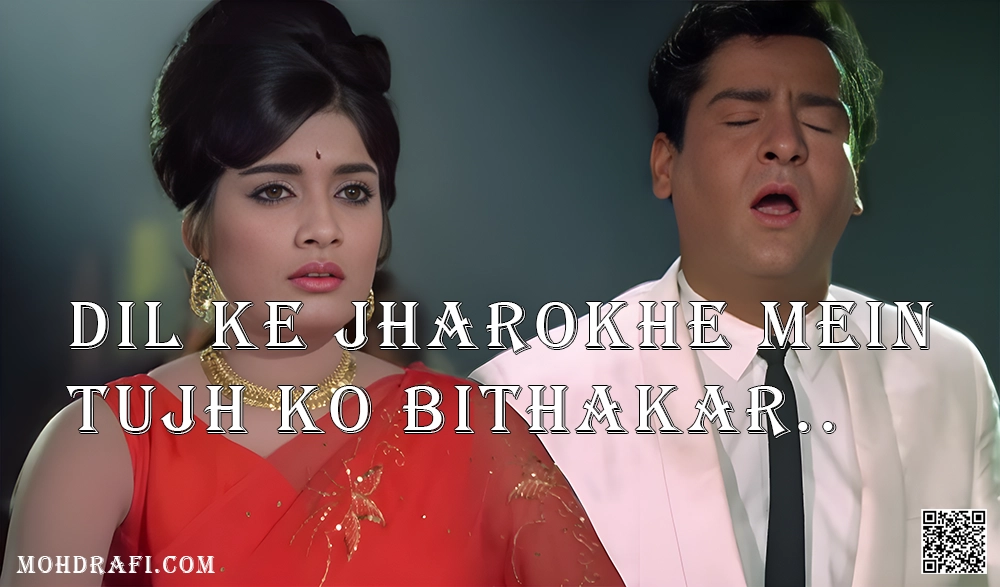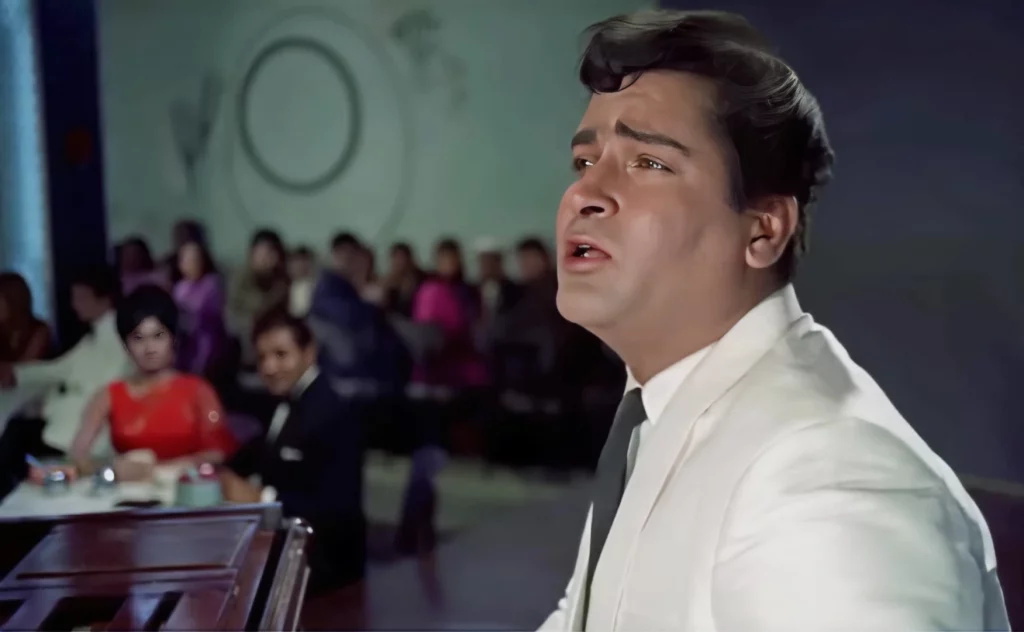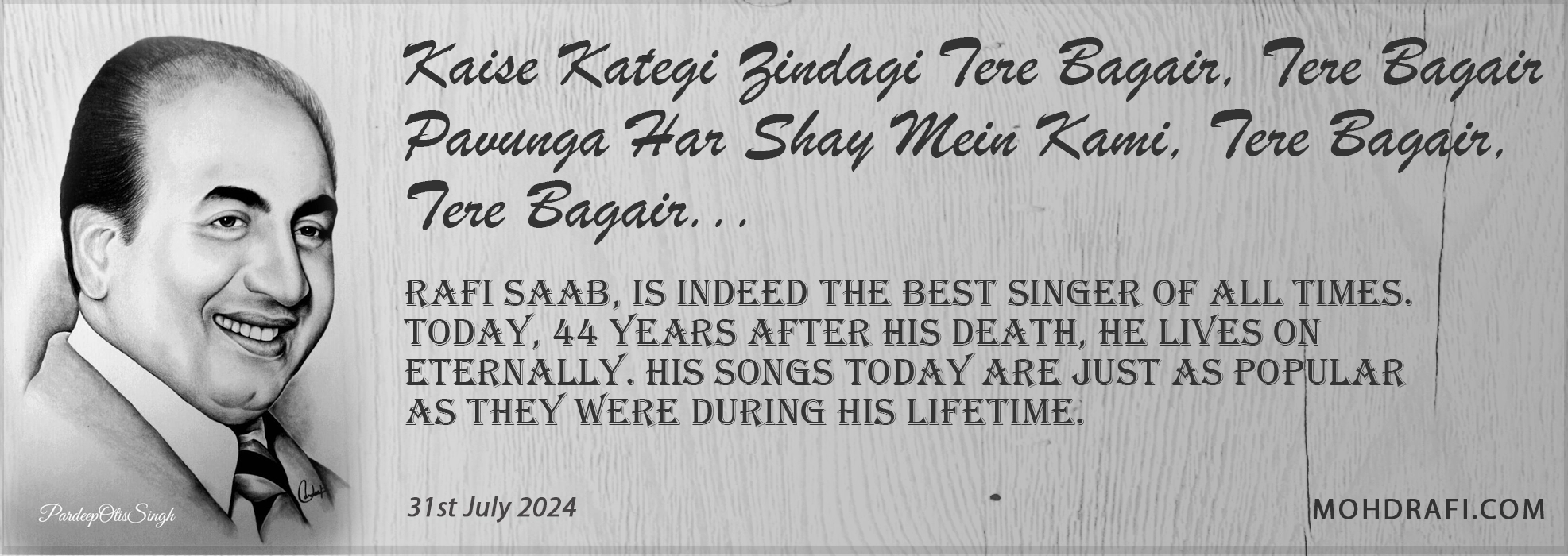Dil Ke Jharokhe Mein: A Soulful Masterpiece by Mohammed Rafi
Mohammed Rafi’s soulful rendition of “Dil Ke Jharokhe Mein” is a timeless expression of love and devotion, beautifully capturing the essence of eternal affection.

When we talk about timeless classics that touch the heart’s deepest chords, Mohammed Rafi’s “Dil Ke Jharokhe Mein” from the 1968 film Brahmachari stands out as a poignant expression of love, longing, and eternal devotion. As a die-hard fan of Mohammed Rafi, this song holds a special place in my heart, not just for its melody but for the sheer depth and emotion that Rafi Sahab brings to life with his impeccable voice.
“Dil Ke Jharokhe Mein” is a song that transcends time, effortlessly conveying the pain of separation and the hope of eternal love. The lyrics by Hasrat Jaipuri are a masterpiece of poetic expression, beautifully capturing the essence of a lover’s unwavering devotion. Rafi Sahab’s rendition is nothing short of magical; his voice carries the weight of every word, making you feel the emotions as if they were your own.
Based on raag Shivaranjani, this song’s melody, composed by the legendary duo Shankar-Jaikishan, complements the lyrics perfectly, creating a hauntingly beautiful harmony that lingers long after the song has ended.
One of the most fascinating anecdotes about this song is the challenge posed by Shammi Kapoor to Mohammed Rafi Sahab during the recording. Shammi Kapoor, known for his vibrant personality, humorously challenged Rafi Sahab to sing the opening and the interlude of the song in one breath.
Mohammed Rafi Sahab, with his characteristic humility and unmatched talent, took on the challenge and recorded the opening and the interlude in a single breath, much to everyone’s amazement. This anecdote not only highlights Rafi Sahab’s extraordinary vocal prowess but also the respect and camaraderie shared between him and the actors he sang for.
Unfortunately, in my view, Shammi Kapoor couldn’t quite match the scale of Mohammed Rafi. The high octaves were not justified in his performance, as he didn’t put enough effort into matching the vocal intensity that Mohammed Rafi brought to this song.
The lyrics of “Dil Ke Jharokhe Mein” are a beautiful tapestry of emotions, each verse unfolding a new layer of the lover’s devotion. Let’s delve deeper into the meaning behind these soulful lines:
दिल के झरोखे में, तुझको बिठाकर,
यादों को तेरी मैं दुल्हन बनाकर,
रखूँगा मैं दिल के पास,
मत हो मेरी जान उदास..
Dil Ke Jharokhe Mein, Tujhjo Bithakar,
Yaadon Ko Teri Mein Dulhan Banakar,
Rakhunga Mein Dil Ke Paas,
Mat Ho Meri Jaan Udhaas..
In these opening lines, Shammi Kapoor expresses his deep affection, visualizing his beloved Rajshree as a bride who resides in the window of his heart. He promises to keep her memories close, urging her not to be sad. The imagery here is both tender and powerful, depicting love as a sacred bond that transcends physical presence.
कल तेरे जलवे पराये भी होंगे,
लेकिन झलक मेरे ख्वाबों में होंगे,
फूलों की डोली में होगी तू रुखसत,
लेकिन महक मेरे सांसों में होगी..
Kal Tere Jalve Paraye Bhi Honge,
Lekin Jhalak Mere Khawabon Mein Honge,
Phoolon Ki Doli Mein Hogi Tu Ruksat,
Lekin Mahak Mere Saanson Mein Hogi..
These lines evoke the pain of impending separation, as Shammi Kapoor anticipates the day when his Rajshree will belong to someone else. Yet, he finds solace in the thought that her essence will remain with him, her fragrance lingering in his breath. The lyricist Hasrat Sahab beautifully contrasts the joy of marriage with the sorrow of parting, reflecting the bittersweet nature of love.
अब भी तेरे सुरख होंठों के प्याले,
मेरे तसव्वुर में साकी बने हैं,
अब भी तेरी ज़ुल्फ के मस्त साए,
बिरहा की धूप में साथी बने हैं..
Ab Bhi Tere Surk Honton Ke Pyaale,
Mere Tassavur Mein Saaqi Bane Hein.
Ab Bhi Teri Zulf Ke Mast Saaye,
Birha Ki Dhoop Mein Saathi Bane Hein..
Here, Shammi Kapoor reminisces about the beauty of Rajshree, with her rosy lips and intoxicating curls still vivid in his imagination. Despite the physical distance, these memories provide comfort, becoming his companions in the harsh sunlight of separation. The poetic use of metaphors here is striking, painting a picture of love that persists despite all odds.
मेरी मोहब्बत को ठुकरा दे चाहे,
मैं कोई तुझसे ना शिकवा करूंगा,
आँखों में रहती है तस्वीर तेरी,
सारी उमर तेरी पूजा करूंगा..
Meri Mohobbat Ko Thukrade Chahe,
Mein Koyi Tujh Se Na Shikwa Karunga,
Aankhon Mein Rehti Hai Tasaveer Teri,
Saari Umar Teri Pooja Karunga..
In the final verse, Shammi Kapoor declares his unconditional love, willing to endure rejection without complaint. His devotion is unwavering, as he vows to keep Rajshree’s image alive in his eyes and worship her for the rest of his life. This ultimate expression of selfless love is what makes the song resonate so deeply with listeners.

The lyricist Hasrat Jaipuri, known for his evocative and heart-touching poetry, penned many memorable songs that were brought to life by Mohammed Rafi’s unparalleled voice. Some of his other notable works include “Baharon Phool Barsao” from Suraj and “Teri Pyari Pyari Surat Ko” from Sasural, both of which are iconic in their own right.
The musical composition by Shankar-Jaikishan in “Dil Ke Jharokhe Mein” is a fine example of their genius. The duo’s ability to blend classical and contemporary elements created a unique sound that defined an era. Other songs composed by them and sung by Rafi Sahab, such as “Ghungharwa Mora Chham Chham” from Zindagi (1964) and “Yeh Mera Prem Patra Padkar” from Sangam (1964), continue to be cherished by music lovers across generations.
Brahmachari, the movie in which this song is featured, was a major hit, known for its social message and outstanding performances by Shammi Kapoor and Rajshree. The film’s music played a significant role in its success, with “Dil Ke Jharokhe Mein” being one of its most celebrated tracks. Despite the challenge of matching Rafi Sahab’s vocal intensity, Shammi Kapoor’s on-screen presence added a unique charm to the song’s picturization.
Film: Brahmachari
Year: 1968
Singer: Mohammed Rafi
Lyrics: Hasrat Jaipuri
Music: Shankar Jaikishan
Actors: Shammi Kapoor, Rajshree

Thank you Ramesh Ji for this information. SJ’s innovative approach in blending Western and Indian classical elements truly set this song apart. The 1-2-3 rhythm of the Waltz, especially in a medium-fast tempo, added a distinctive flair… It’s surprising to think about how the Waltz, once considered vulgar during Victorian times.
This is a classic fusion of Waltz and Raag Shivranjani which has probably not been done by anybody else. SJ had many songs in “Waltz” format ; the 1-2-3; 1-2-3 rhythm was once considered “vulgar” during Victorian days! Most waltzes Hndi films are slow paced but this one is somewhere between medium and fast! Needless to say Rafi saab takes it to a new height!